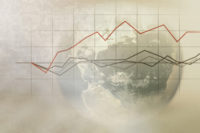For those who missed the recovery, it’s probably a little unnerving to consider “this” a bull market or an economic recovery.
And it’s probably just as unnerving to think that we’re already primed for another correction.
While the markets may be performing well, the average American isn’t.
Unemployment remains high, as does household debt. Gross domestic product (GDP) is essentially flat. Housing may be the one bright spot, but even that sector is fragile at best.
How does the Congressional Budget Office (CBO) feel about the U.S economic outlook in 2014?
Pessimistic.
Moribund expectations
The CBO expects the U.S. economy in 2014 to remain moribund and for unemployment to remain near eight percent. But it gets better. It also projects that both actual and potential real GDP will eke out 2.25% annual gains between 2019 and 2023. (Source: “The Budget and Economic Outlook: Fiscal Years 2013 to 2023,” Congressional Budget Office web site, February 2013.)
For the average American trying to make ends meet in 2014, a bull market and a recession will probably look—and feel—the same.
The roots of America’s financial crisis and the U.S economic outlook for 2014 can be traced back to 2007, when the U.S. housing bubble burst. This sent the dominos tumbling, and the United States entered an economic meltdown in 2008. Despite government intervention, the economy has sputtered and slipped in and out of recession.
Since 2008, the actions of the Federal Reserve have put the U.S. on a path to economic failure. To stem the economic slide of the U.S. housing collapse that first surfaced in 2005, the Federal Reserve unveiled three different quantitative easing (QE) efforts. Since 2008, the Federal Reserve has printed off trillions of dollars, and it continues to add to that number at a staggering rate each month.
The extra dollars pumped into the economy were supposed to spur economic growth. It had the reverse effect, shrinking the buying power of each dollar, the driving force of inflation. As the U.S. dollar continues to decline in value against other world currencies, goods imported into the U.S. become more expensive.
Will there be a fourth round of quantitative easing? Probably not. But that’s only because the third round is open-ended. You could even call it “QE Eternity.”
Debt woes
When the financial crisis began in 2008, the U.S. national debt stood at $9.2 trillion. Based on the White House’s own figures, the national debt will reach $20.0 trillion by the end of this decade—about 140% of our current GDP.
The U.S. is not alone. Government debt in advanced economies has climbed to its highest level since World War II. Gross debt levels in many nations, including Japan, Greece, Italy, Portugal, and Ireland, are all above 100%.
Public debt is not a new phenomenon. Since 1900, a number of economically advanced countries have teetered on the heels of serious government debt.
Reducing government debt takes a long time; especially with continued global economic headwinds. That said, even under the best circumstances, it can take years. Case in point: now, 15 years after debt rose above 100%, it’s only marginally lower. (Source: Simon, j., et al., “Press Points for chapter 3: 100 Years of Dealing with Public Debt Overhangs: World Economic Outlook, October 2012,” International Monetary Fund web site, October 2012.)
Successful debt reduction requires fiscal constraint and policies that support growth. This includes supportive monetary policy and measures that address structural weaknesses in the economy.
Those ingredients are not currently in place in the U.S.
Anemic global economy
After five years of support from the Federal Reserve, U.S. economic growth is anemic. The International Monetary Fund (IMF) lowered its growth estimate for the global economy to 3.6% for 2013 and warned that future revisions would likely be lower.
Economic instability, political deadlock, the business community’s mistrust of the government, concerns over its fiscal health, deterioration in the development of its financial markets, and a weak American dollar have cut into corporate America’s bottom line.
These lower margins, in turn, could lead to further layoffs, sending millions of working Americans into unemployment. To rectify the situation, the government increased and expanded taxes to generate capital.
In 2014, we will still be waiting to see the results.
America’s future economic growth will depend on its ability to innovate, create, and reinvent the way it does business. And it will need to meet the growing and evolving untapped demands of an increasingly challenging global environment.
The actions taken since 2008 have put our country’s economic future on the backburner.
The U.S. economic outlook for 2014 is grim. In 2014, investors should be very worried—and they should be prepared.

